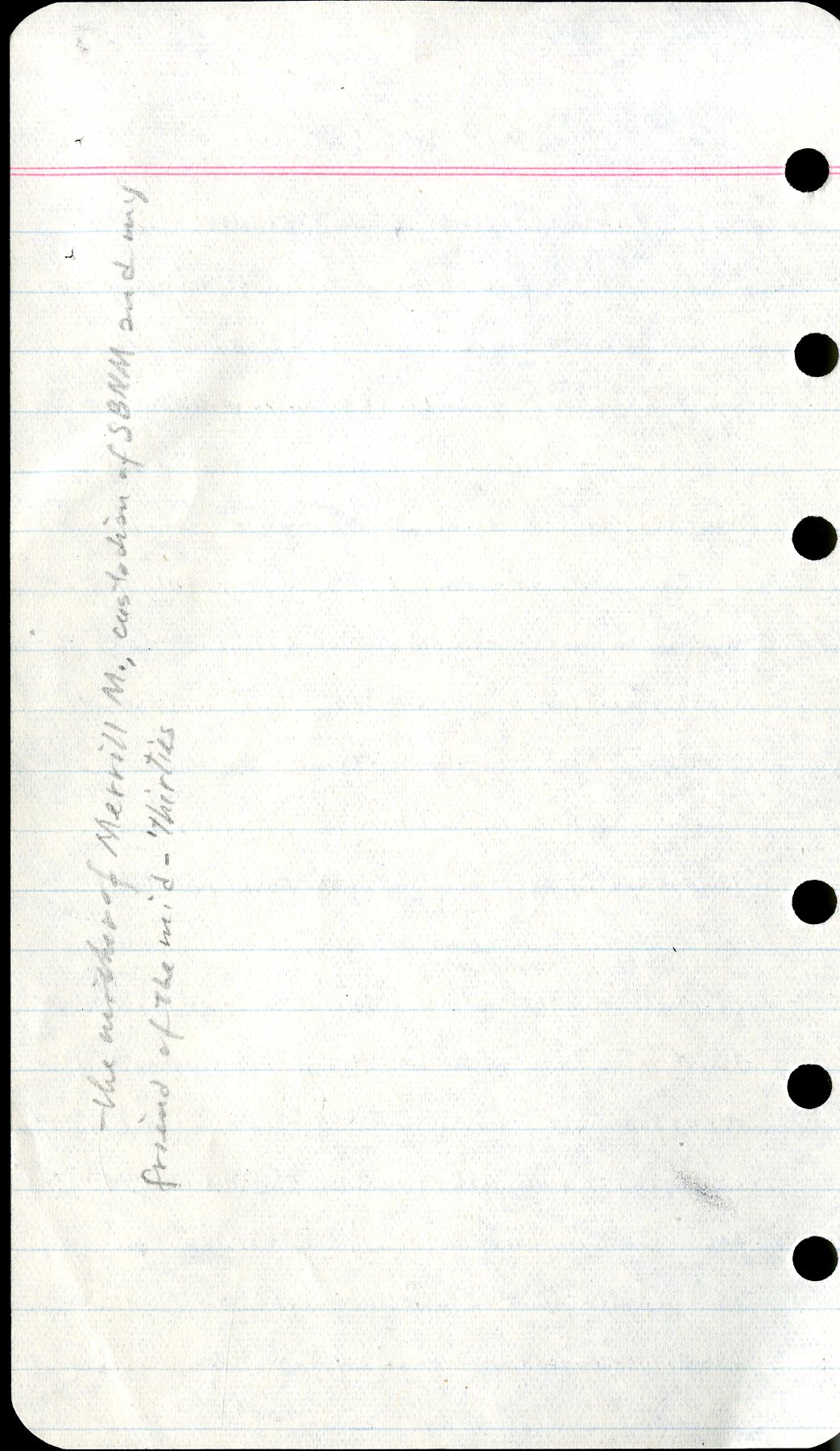Great Nebraska
Naturalists and ScientistsAugust 18, 1946
Handwritten
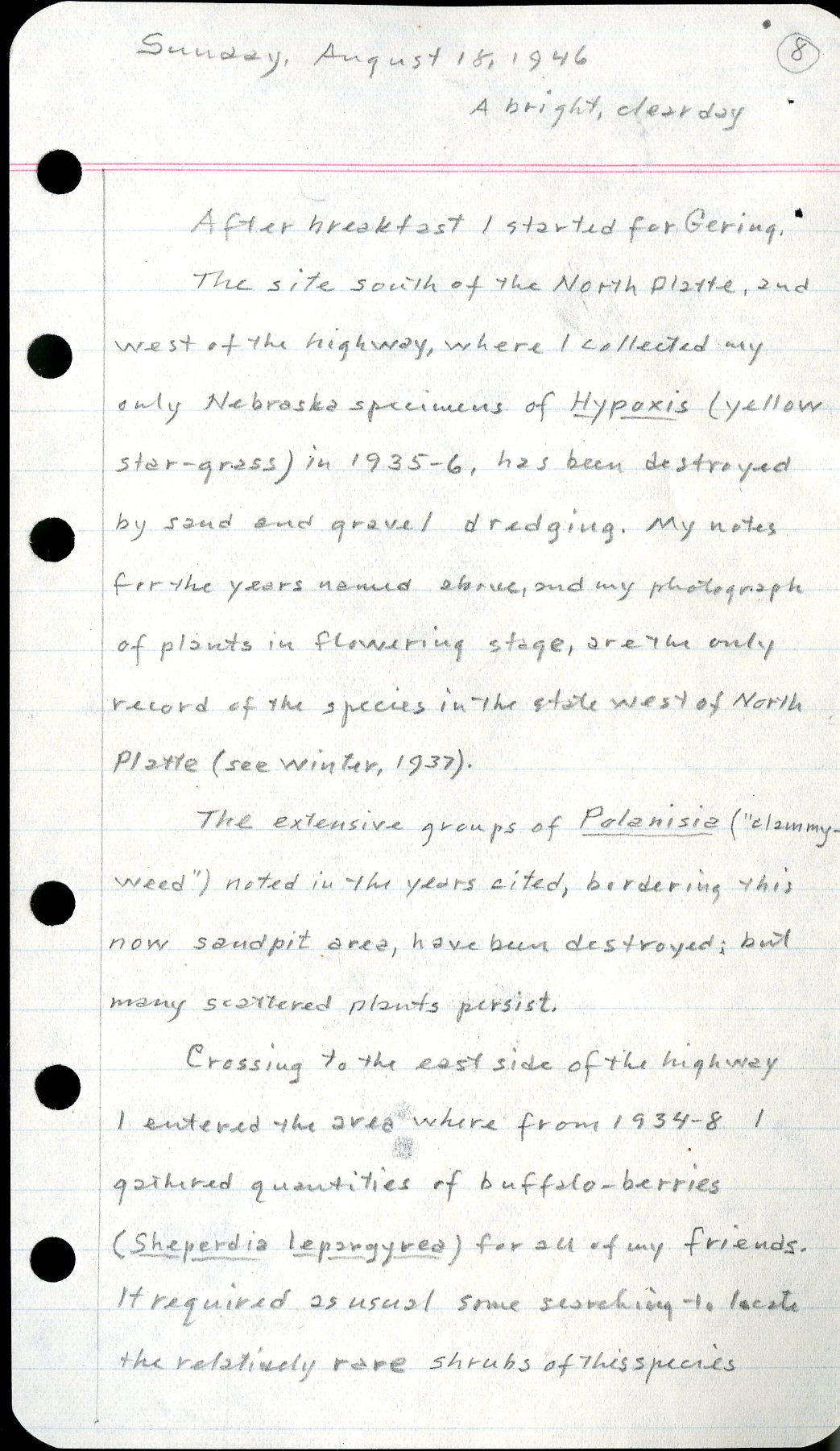
Sunday, August 18, 1946 8 A bright, clear day
After breakfast I started for Gering.
The site south of the North Platte, and west of the highway where I collected my early Nebraska specimens of Hypoxis (yellow star-grass) in 1935-36, has been destroyed by sand and gravel dredging. My notes for the years named above, and my photographs of plants in flowering stage, are the only record of the species in the state west of North Platte (see winter, 1937).
The extensive groups of Polanisia (“clammy-weed”) noted in the years cited, bordering this now sandpit area, have been destroyed; but many scattered plants persist.
Crossing to the east side of the highway I entered the area where from 1934-38 I gathered quantities of buffalo-berries (Sheperdia lepangyrea) for all of my friends. It required as usual some searching to locate the relatively rare shrubs of this species
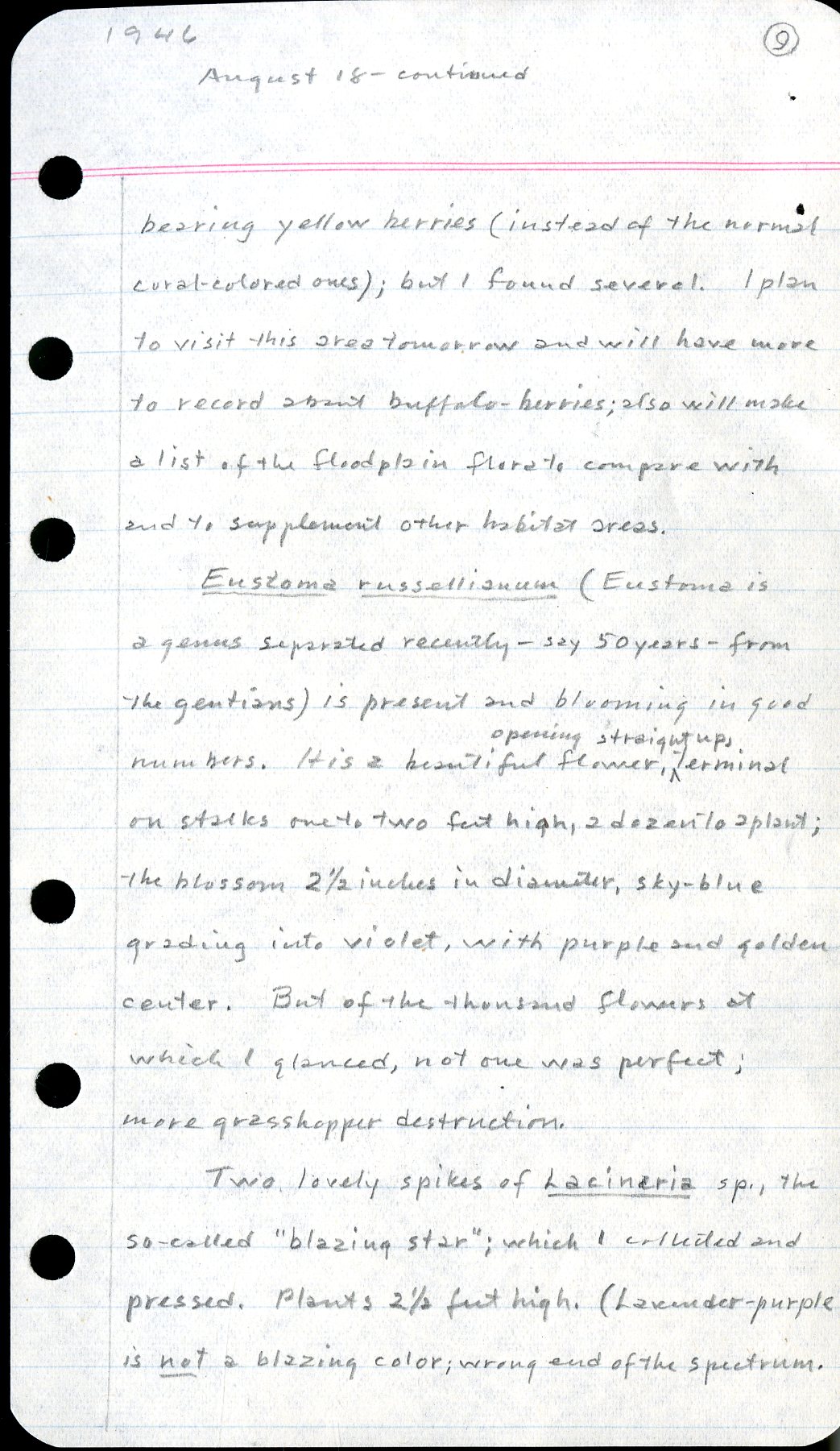
1946 9 August 18 – continued
bearing yellow berries (instead of the normal corral-colored ones); but I found several. I plan to visit this area tomorrow and will have more to record about buffalo-berries; also will make a list of the floodplain flora to compare with and to supplement other habitat areas.
Eustoma russelianum (Eustroma is a genus separated recently – say 50 years – from the gentians) is present and blooming in good numbers. It is a beautiful flower, opening straight, terminal on stalks one to two feet high, 2 dozen to a plant; the blossom 2 ½ inches in diameter, sky-blue grading into violet, with purple and golden center. But of the thousand flowers at which I glanced, not one was perfect; more grasshopper destruction.
Two lovely spikes of hacineria sp., the so-called “blazing star”; which I collected and pressed. Plants 2 ½ feet high. (Lavender-purple in not a blazing color; wrong end of the spectrum.
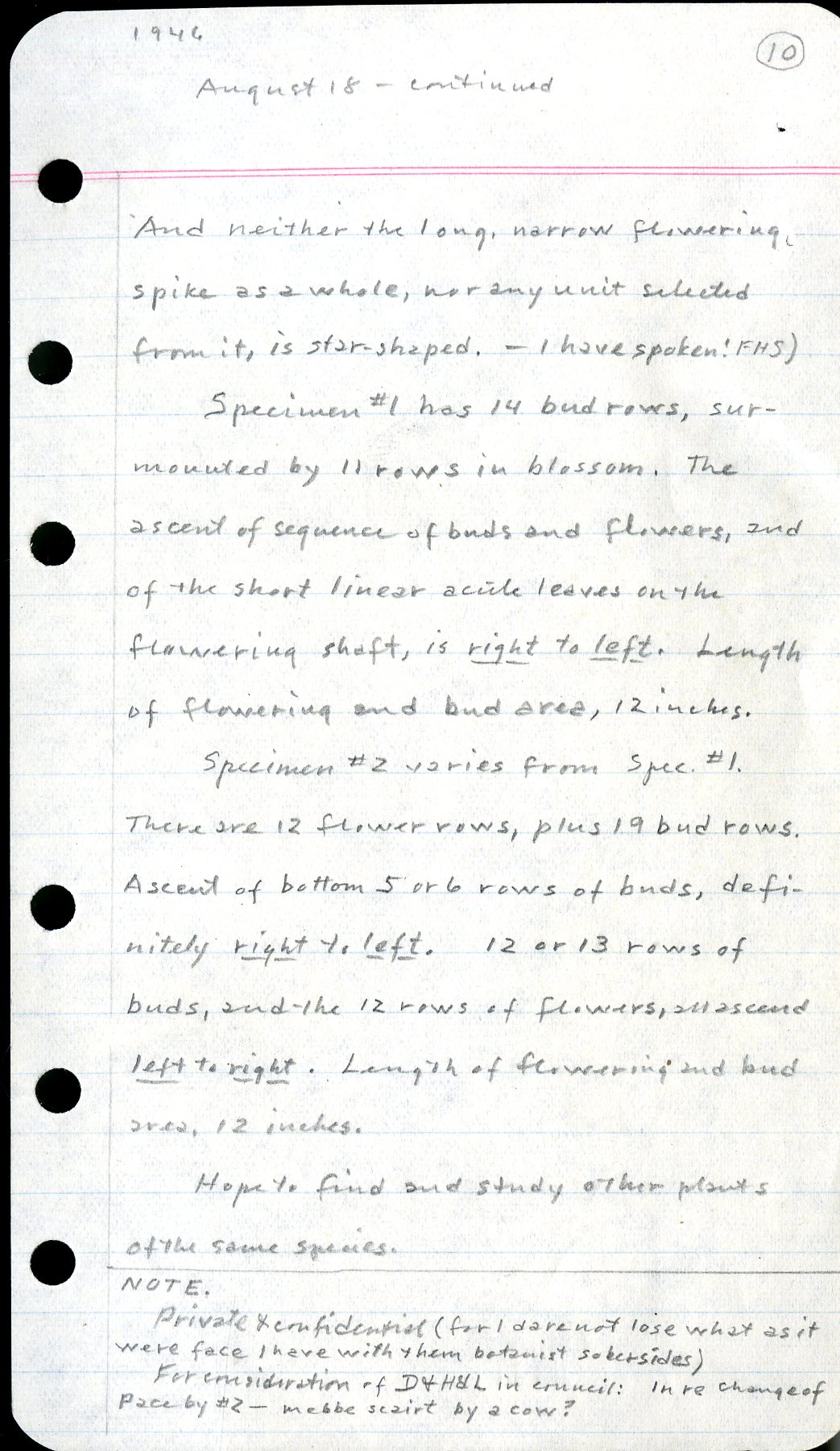
1946 10August 18 – continued
And neither the long narrow flowering spike as a whole, nor any unit selected from it, is star-shaped. – I have spoken! FHS)
Specimen #1 has 14 bud rows, surmounted by 11 rows in blossom. The ascent of sequence of buds and flowers, and of the short linear acute leaves on the flowering shaft, is right to left. Length of flowering and bud area, 12 inches.
Specimen #2 varies from Spec. #1. There are 12 flower rows, plus 19 bud rows. Ascent of bottom 5 orb rows of buds, definitely right to left. 12 or 13 rows of buds, and the 12 rows of flowers, all ascend left to right. Length of flowering and bud area, 12 inches.
Hope to find and study other plants of the same species.
____________________________________________ NOTE.
Private + confidential (for I dare not lose what as it were face I have with them botanist sober sides)
For consideration of D+H&L in council: In re change of pace by #2 – mebbe scairt by a cow?

1946 11
August 18 – continued
I reached Gering, and after lunch I went to the Laughlin home to get my botany MSS.; no one there, so adopting suggestion of Laughlin when I met him yesterday, I went in – door unlocked, as he had prophesied – and readily found them. With what I carried it made quite an armful; so presently I entered the post-office, almost empty on Sundays, to use desk space for reassembling the papers, while so doing Mrs. Mattes entered; so I gave her numerous botany and bird (flycatchers and leteridae) paper to take home and peruse.
Then it occurred to me to call on Wylma Nichols’ mother. I was abrut to leave and hunt up a telephone directory to find her address, when a women turned from her box carrying a fair lot of mail. She’ll know! I told Me. So I inquired politely [I just love to brag!], stating the fact of my friendship with the family several years ago, before Wylma’s marriage,
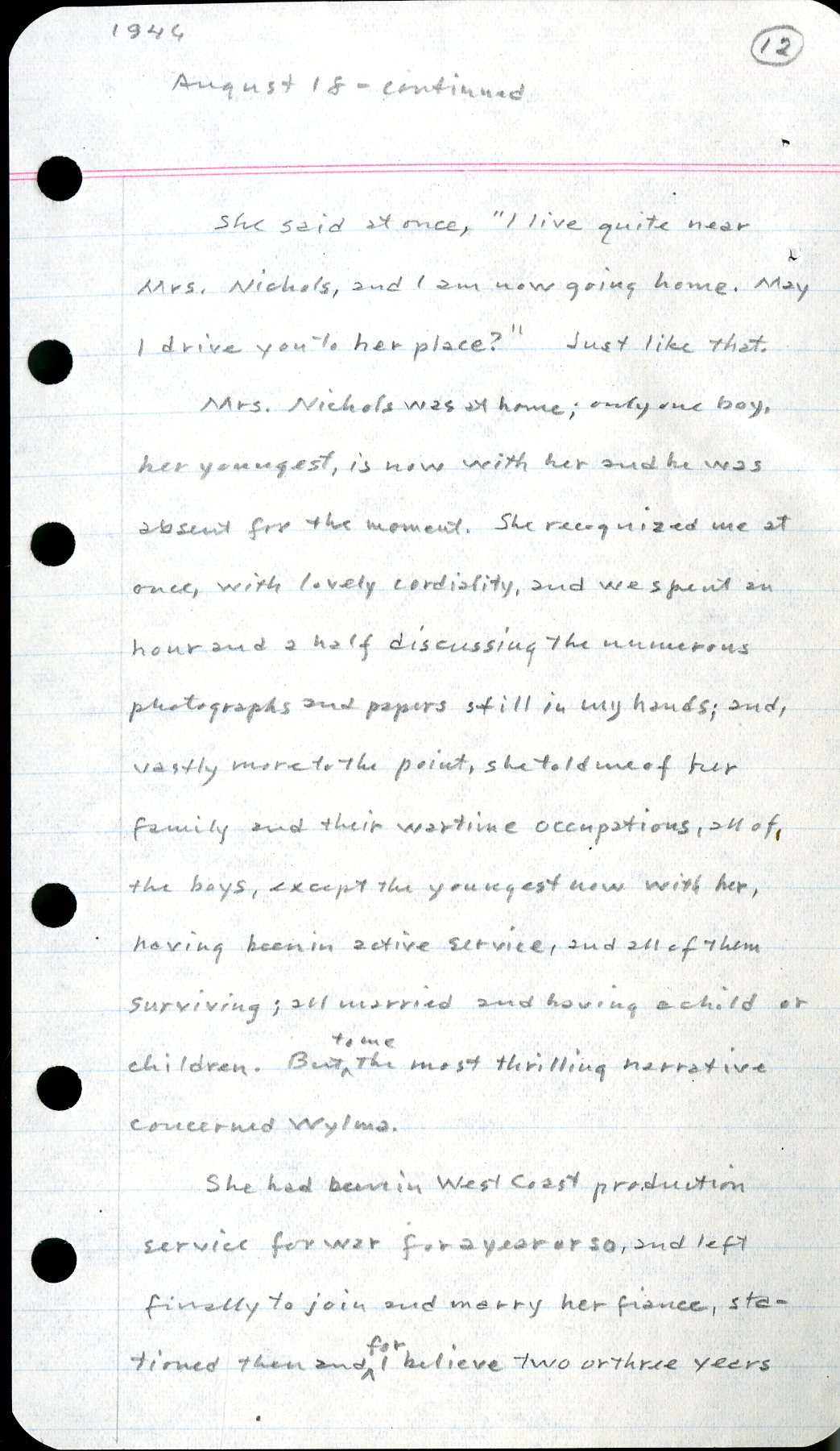
1946 12 August 18 – continued
She said at once, “I live quite near Mrs. Nichols, and I am now going home. May I drive you to her place?” Just like that.
Mrs. Nichols was at home; only one boy, her youngest is now with her and was absent for the moment. She recognized me at once, with lovely cordiality, and we spent an hour and a half discussing the numerous photographs and papers still in my hands; and, vastly more to the point, she told me of her family and their wartime occupations, and of, the boys, except the youngest now with her, having been in active service, and all of them surviving; all married and having a child or children. But to me the most thrilling narrative concerned Wylma.
She had been in West Coast production service for war for a year or so, and left finally to join and marry her fiancé, stationed then and for I believe two or three years
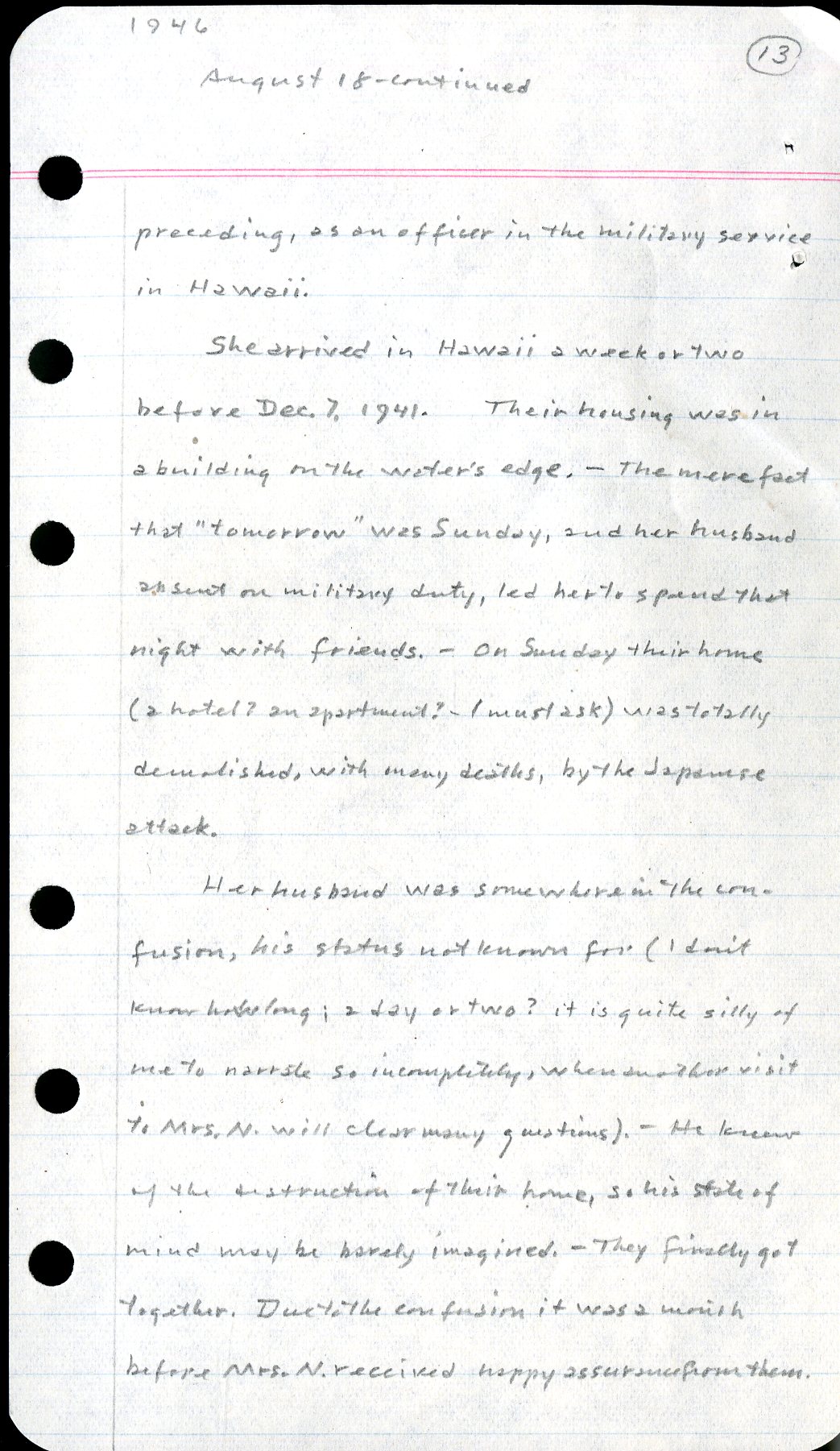
1946 13
August 18 – continued
Preceding, as an officer in the military service in Hawaii.
She arrived in Hawaii a week or two before Dec. 7, 1941. Their housing was in a building on the water’s edge. – the mere fact that “tomorrow” was Sunday, and her husband absent on military duty, led her to spend that night with friends. – On Sunday their (a hotel? An apartment? – I must ask) was totally demolished, with many deaths, by the Japanese attack.
Hyer husband was somewhere in the confusion, his status not known for (I don’t know how long; a day or two? it is quite silly of me to narrate so incompletely, when another visit to Mrs. N. will clear many questions). – He learns of the destruction of their, so his state of mind may be barely imagined. – They finally got together. Due to the confusion it was a month before Mrs. N. received happy assurance from them.
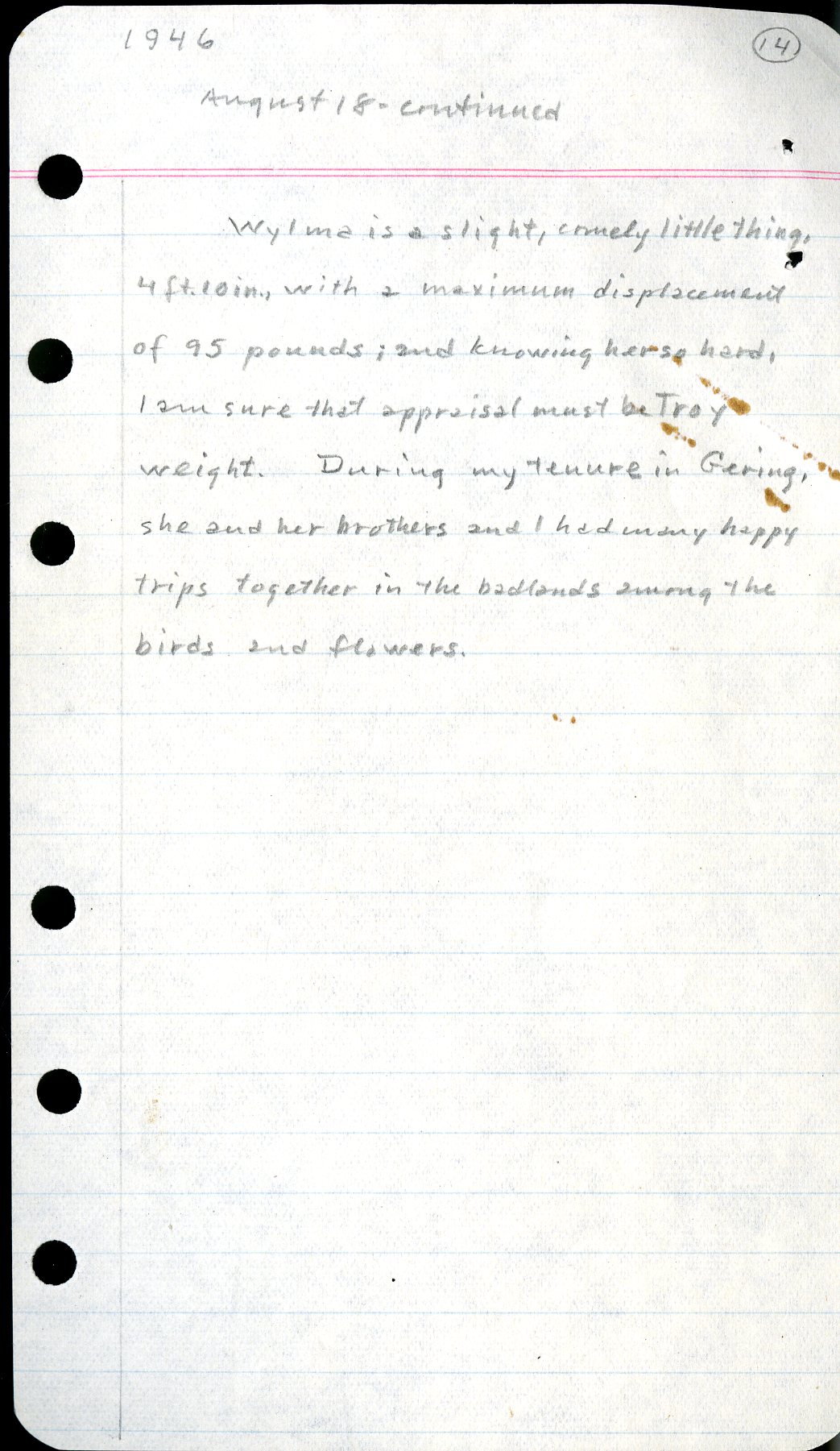
1946 14
August 18 – continued
Wylma is a slight, comely little thing, 4fr.10in., with a maximum displacement of 95 pounds; and knowing her so hard, I am sure that appraisal must be Troy weight. During my tenure in Gering she and her brother and I had many happy trips together in the badlands among the birds and flowers.
August 18, 1946
Transcribed
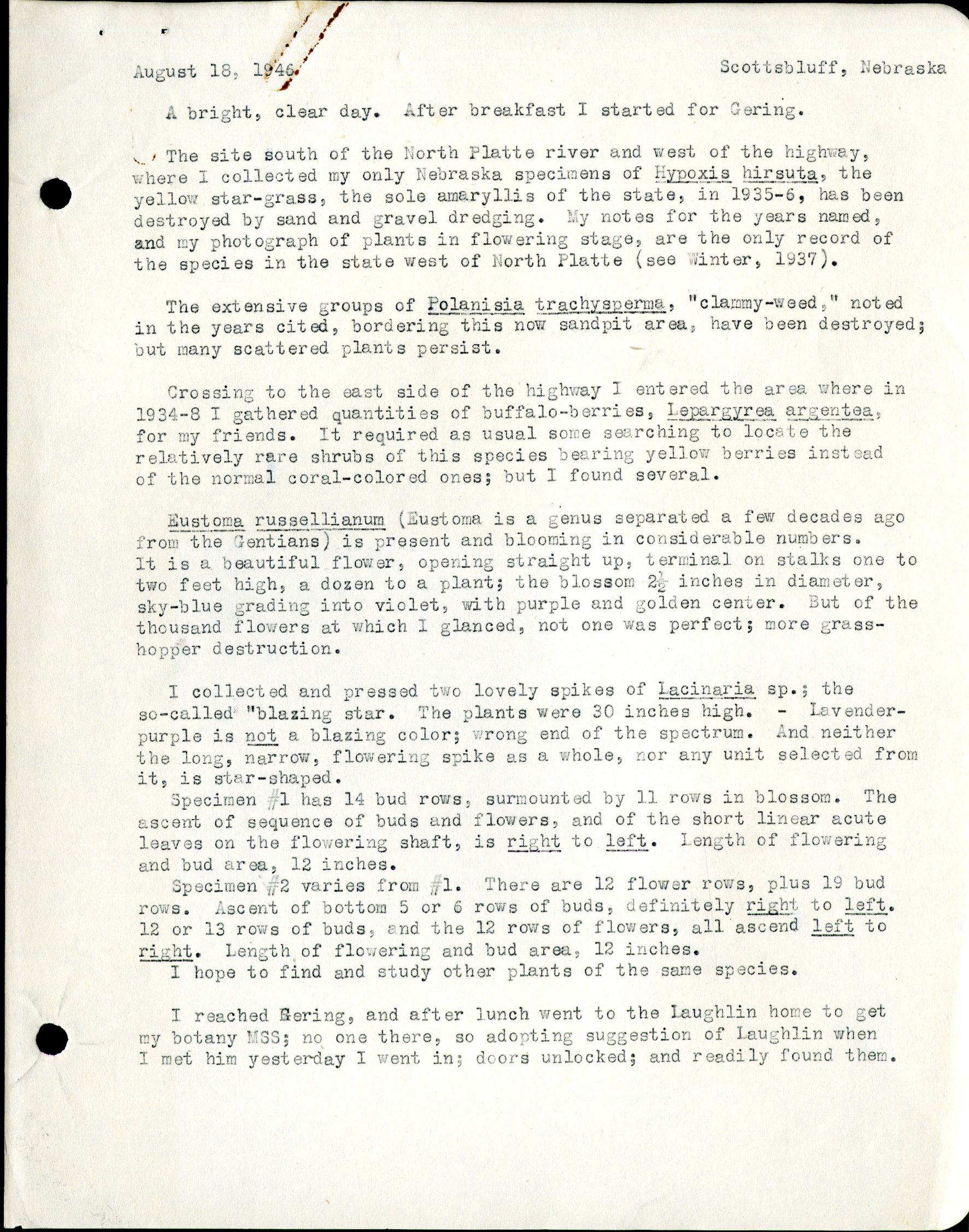
August 18, 1946 Scottsbluff, Nebraska
A bright, clear day. After breakfast I started for Gering.
The site south of the North Platte river and west of the highway, where I collected my only Nebraska specimens of Hypoxis hirsute, the yellow star grass, the sole amaryllis of the state, in 1935-6, has been destroyed by sand and gravel dredging. My notes for the years named, and my photograph of plants in flowering stage, are the only record of the species in the state west of North Platte (see Winter, 1937).
The extensive groups of Polanisia trachysperma, “clammy-weed,” noted in the years cited, bordering this now sandpit area, have been destroyed; but scattered plants persist.
Crossing to the east side of the highway I entered the area where in 1934-8 I gathered quantities of buffalo-berries, Lepargyrea argentea for my friends. It required as usual some searching to locate the relatively rare shrubs of this species bearing yellow berries instead of the normal coral-colored ones; but I found several.
Eustoma russellianum (Eustoma is a genus separated a few decades ago from the Gentians) is present and blooming in considerable numbers. It is a beautiful flower, opening straight up, terminal on stalks one to two feet high, a dozen to a plant; the blossom 2 ½ inches in diameter, sky-blue grading into violet, with purple and golden center. But of the thousand flowers at which I glanced, not one was perfect; more grass-hopper destruction.
I collected and pressed two lovely spikes of Lacinaria sp.; the so-called “blazing star. The plants were 30 inches high. – Lavender-purple is not a blazing color; wrong end of the spectrum. And neither the long, narrow flowering spike as a whole, nor any unit selected from it, is star-shaped.
Specimen #1 has 14 bud rows, surmounted by 11 rows in blossom. The ascent of sequence of buds and flowers, and of the short linear acute leaves on the flowering shaft, is right to left. Length of flowering and bud area, 12 inches.
Specimen #2 varies from #1. There are 12 flower rows, plus 19 bud rows. Ascent of bottom 5 or 6 rows of buds, definitely right to left. 12 or 13 rows of buds, and the 12 rows of flower, all ascend left to right. Length of flowering and bud area, 12 inches.
I hope to find and study other plants of the same species.
I reached Gering, and after lunch went to the Laughlin home to get my botany MSS; no one there, so adopting suggestion of Laughlin when I met him yesterday I went in; doors unlocked; and readily found them.

Aug. 18, ’46 (sheet 2)
With what I carried it made quite an armful; so presently I entered the postoffice, almost empty on Sundays, to use desk space for reassembling the papers; and while so doing, Mrs. Mattes entered. She is the mother of Merrill Mattes, custodian of Scott’s Bluff National and my friend and daily associate of the mid-‘thirties; so I gave her numerous botany and bird papers to take home and look over. Merrill’s early return from an eastern trip is expected.
Then it occurred to me to call on Wylma Nichols’ mother. I was about to leave the postoffice and hunt up a telephone directory to find her address, when a woman turned from her box, carrying a fair lot of mail; she will know, I thought. So I ventured to inquire, stating the fact of my friendship with the family several years ago, before Wylam’s marriage. She said at once, “I live quite near Mrs. Nichols, and I am now going home. May I drive you to her place?”
I found Mrs. Nichols at home; only one boy, her youngest, is now with her, and he was absent for the moment. She recognized me at once with lovely cordiality, after my absence of eight years, and we visited for an hour and a half. She told me of her family and their wartime occupations; all of the boys, except the youngest now with her, having been in active service, and all of them surviving; all married, and having a child or children. But to me the most thrilling narrative concerned Wylma.
She had been in West Coast production service for war, for a year or two, and left San Diego finally to join and marry her fiancé, stationed then and I believe for two to three years preceding, as an officer in the military service at Pearl Harbor. She reached Hawaii late in November, and they were married at once.
Their housing was in a building on the water’s edge. – On December 6, the mere fact that “tomorrow” was Sunday and her husband absent on military duty, led her to spend that nigh t with friends. – On Sunday December 7, their home (a hotel? apartment house?) was totally demolished with many deaths, by the Japanese attack.
Her husband was somewhere in the confusion, his status not known for days. Meanwhile he of course knew of the destruction of their home, so his state of mind may be barely imagined. They finally got together. But it was a month before Mrs. Nichols received happy assurance.
Wylma is a slight, comely little thing, about 4 ft. 10in., with a maximum displacement of 95 pounds; and I am sure that that appraisal must be in troy weight. During my tenure in Gering, she and her brothers and I had many happy trips together, about the Bluff and in the badlands, among the flowers and birds.
—
August 21, 1946
Transcribed

Aug. 21, 1946 Scottsbluff, Nebraska
Species of plants observed in brief survey, south end of bridge over North Platte River between Scottsbluff and Gering:
Willow, sandbar Willow, peach-leaved Amorpha fruticose Chaetochloa verticillata Chaetochloa glauxa Iva xanthiifolia Cottonwood Symphoricarpos occidentalis Prostrate amaranth Green amaranth Swamp grass (Spartina sp.) Grindelia squarrosa Kochia sp. Rumex sp. Past flowering Elymus Canadensis Cocklebur Solanum rostratum flowering Polypogon monspelinesis Am. Brooklime (Veronica) fl White sweet clover Oenothera biennis Micrampelis lobate fl Cat-tail (T. latifolia) Rosa pratincola fruiting Prickly poppy pf Catnip Wild licorice Western ragweed Bromus tectorum pf & Dead Polansia trachysperma fl Toxicodendron rydbergii Russian thistle Gaura parviflora fl Helianthus sp. Russian olive Buffalo-berry (Lepargyrea argentea Nutt.) fr Great lobelia fl Eustoma russellianum fl Prostrate spurge Swamp milkweed fl Squirrel-tail (Hordeum) Pot entilla sp. Aster sp. (pre-fl) Plantago lanceolate
Black currant Knotgrass (Polygonum aviculare) Bluegrass (Poa pratensis) post-fl Dandelion Purslane (Portulaca oleracea) Physalis app. (2) Barnyard grass (E. crus-galli) Puncture-vine (Tribulus terrestris) fl&fr Wild salsify Tall knotweed (P. erectum) Stinkgrass (Eragrostis major) Wheat grass Buffalo bur Mustard sp. Polygonum Spp. (2) Mentha sp. Solidago spp. (3) Asclepial syriaca Primrose sp.; pink fl Sage sp. Verbena sp. Sedge spp. (2)
August 21, 1946
Hand Notes
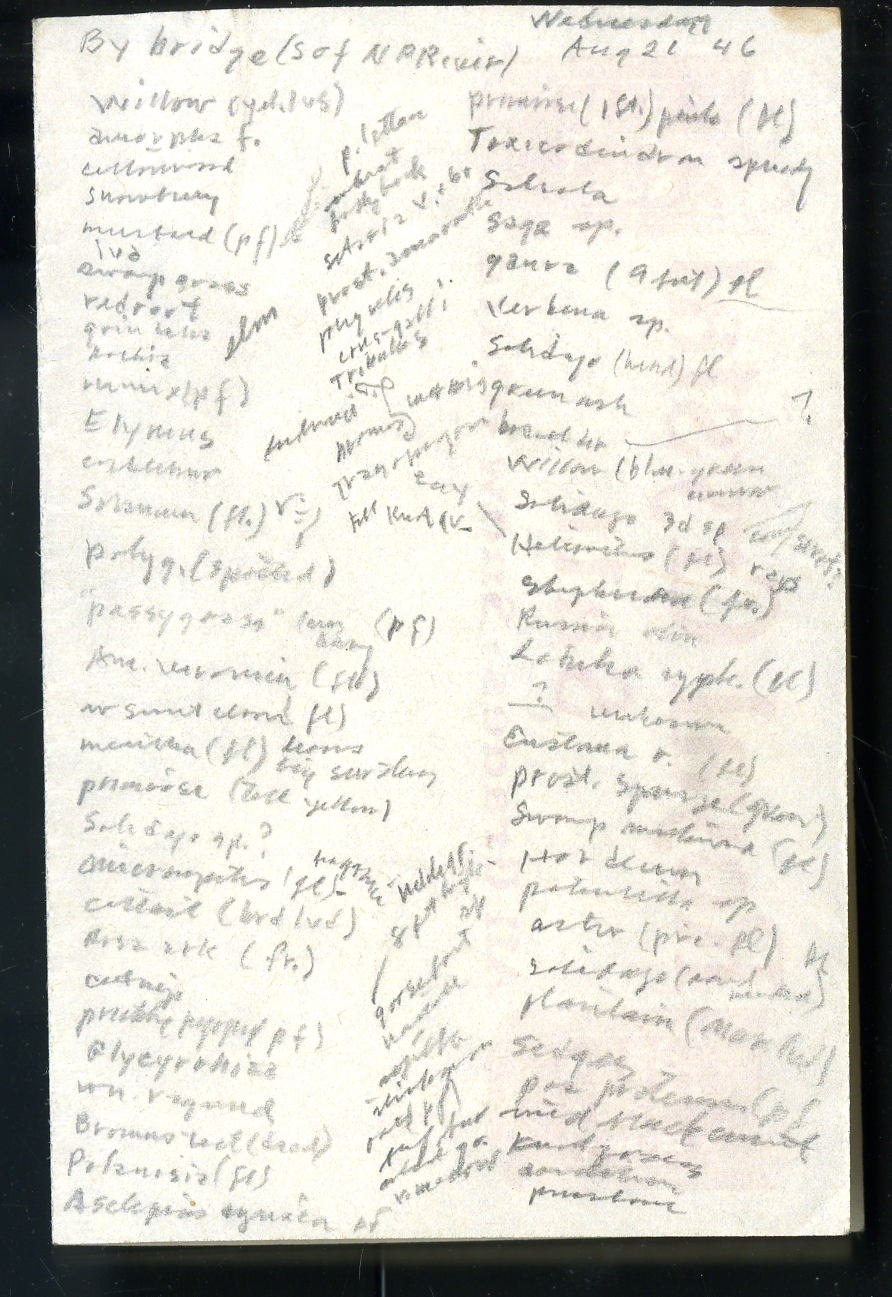
Wedburden(?) Aug 21 ‘46
By bridge (S of NP River) Willow (yel. Lus) Amorpha f. [unclear] Snowberry Mustard (pf) Iva Swamp grass Redroot [unclear] Rochia [unclear] Elymus [unclear] Solanum (fl.) [unclear] “passygrass” [unclear] (pf) Am. Veronica (fl) [unclear] [unclear] Primrose (tall yellow) Solidago sp. ?
Wednesday Aug 21 46 Primrose (1st) pink (fl) Toxicodendron [unclear] [unclear] Sage sp. guara ([unclear]) fl Kochina sp. Solidago ([unclear]) fl green ash [unclear] Willow (blue-green [unclear] Solidago 3d sp [unclear] sweet? Helianthus (fr) reys [unclear] (fr.) Russian olive Lobelia [unclear] (fl) ? [unclear] Eustoma r. (fl) Prost. Spurge (green) [unclear] [unclear] potentilla sp Aster (pre-fl) Solidago ([unclear]) fl [unclear] Sedges Poa pratensis (p f Vine of [unclear] Knotgrasses [unclear] [unclear]
